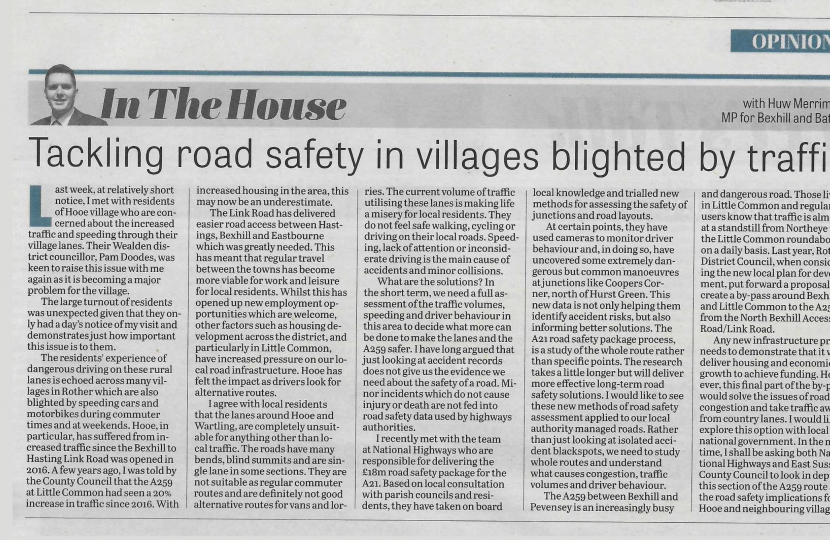
Last week, at relatively short notice, I met with residents of Hooe village who are concerned about the increased traffic and speeding through their village lanes. Their Wealden district councillor, Pam Doodes, was keen to raise this issue with me again as it is becoming a major problem for the village. The large turnout of residents was unexpected given that they only had a day’s notice of my visit and demonstrates just how important this issue is to them.
The residents’ experience of dangerous driving on these rural lanes is echoed across many villages in Rother which are also blighted by speeding cars and motorbikes during commuter times and at weekends. Hooe, in particular, has suffered from increased traffic since the Bexhill to Hasting Link Road was opened in 2016. A few years ago, I was told by the County Council that the A259 at Little Common had seen a 20% increase in traffic since 2016. With increased housing in the area, this may now be an underestimate.
The Link Road has delivered easier road access between Hastings, Bexhill and Eastbourne which was greatly needed. This has meant that regular travel between the towns has become more viable for work and leisure for local residents. Whilst this has opened up new employment opportunities which are welcome, other factors such as housing development across the district, and particularly in Little Common, have increased pressure on our local road infrastructure. Hooe has felt the impact as drivers look for alternative routes.
I agree with local residents that the lanes around Hooe and Wartling, are completely unsuitable for anything other than local traffic. The roads have many bends, blind summits and are single lane in some sections. They are not suitable as regular commuter routes and are definitely not good alternative routes for vans and lorries. The current volume of traffic utilising these lanes is making life a misery for local residents. They do not feel safe walking, cycling or driving on their local roads. Speeding, lack of attention or inconsiderate driving is the main cause of accidents and minor collisions.
What are the solutions? In the short term, we need a full assessment of the traffic volumes, speeding and driver behaviour in this area to decide what more can be done to make the lanes and the A259 safer. I have long argued that just looking at accident records does not give us the evidence we need about the safety of a road. Minor incidents which do not cause injury or death are not fed into road safety data used by highways authorities. I recently met with the team at National Highways who are responsible for delivering the £18m road safety package for the A21. Based on local consultation with parish councils and residents, they have taken on board local knowledge and trialled new methods for assessing the safety of junctions and road layouts. At certain points, they have used cameras to monitor driver behaviour and, in doing so, have uncovered some extremely dangerous but common manoeuvres at junctions like Coopers Corner, north of Hurst Green. This new data is not only helping them identify accident risks, but also informing better solutions. The A21 road safety package process, is a study of the whole route rather than specific points. The research takes a little longer but will deliver more effective long-term road safety solutions. I would like to see these new methods of road safety assessment applied to our local authority managed roads. Rather than just looking at isolated accident blackspots, we need to study whole routes and understand what causes congestion, traffic volumes and driver behaviour.
The A259 between Bexhill and Pevensey is an increasingly busy and dangerous road. Those living in Little Common and regular road users know that traffic is almost at a standstill from Northeye to the Little Common roundabout on a daily basis. Last year, Rother District Council, when considering the new local plan for development, put forward a proposal to create a by-pass around Bexhill and Little Common to the A259 from the North Bexhill Access Road/Link Road. Any new infrastructure project needs to demonstrate that it will deliver housing and economic growth to achieve funding. However, this final part of the by-pass would solve the issues of road congestion and take traffic away from country lanes. I would like to explore this option with local and national government. In the meantime, I shall be asking both National Highways and East Sussex County Council to look in depth at this section of the A259 route and the road safety implications for Hooe and neighbouring villages.




